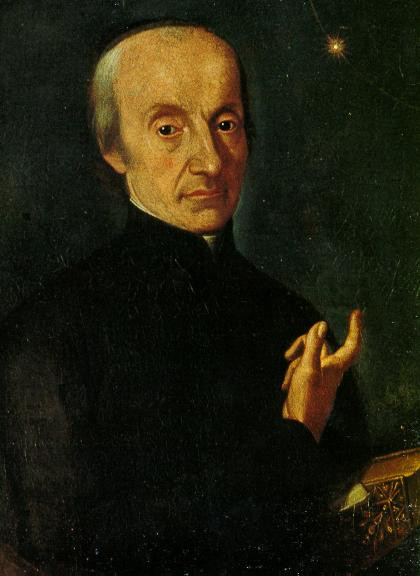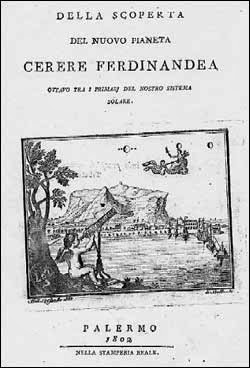
Giuseppe Piazzi (1746-1826)
On January 1, 1801, Italian Catholic priest of the Theatine order, mathematician, and astronomer Giuseppe Piazzi discovered Ceres, today known as the largest member of the asteroid belt. We already had several articles on almost all the planets of the Solar System, including the dwarf planets. [14] As you might know, our Solar System does not only comprise the Sun and the planets Mercury, Venus, Earth, Mars, Jupiter, Saturn, Uranus, and Neptune. Besides the dwarf planets such as e.g., Pluto and Eris, there is an entire flock of smaller rocks and pieces that you will find in the space between the Mars and Jupiter orbit around the Sun, called the asteroid belt. The largest piece of rock there is categorized as a dwarf planet and its name is Ceres, named after the Roman goddess of agriculture.
The Gap between Mars and Jupiter
Already in antiquity, five planets of the solar system visible to the human eye were known: Mercury, Venus, Mars, Jupiter, and Saturn. In 1596, famous astronomer Johannes Kepler had noticed that there is a gap between Mars and Jupiter, and no other planet to fill in [1]. The idea that a still undiscovered planet might exist between the orbits of Mars and Jupiter was suggested by German astronomer Johann Elert Bode in 1772 [2], whose considerations were based on the so-called Titius-Bode law, a now discredited hypothesis which had been first proposed by Johann Daniel Titius in 1766 [3], observing that there was a regular pattern in the semi-major axes of the orbits of known planets marred only by the large gap between Mars and Jupiter. The pattern predicted that the (still) missing planet ought to have an orbit with a semi-major axis near 2.8 AU (AU = Astronomical Units, 1 AU denotes the distance of the Earth from the Sun). Sir William Herschel‘s discovery of planet Uranus in 1781 [4] near the predicted distance for the next body beyond Saturn increased faith in the law of Titius and Bode, and in 1800, they sent requests to twenty-four experienced astronomers, asking to combine their efforts and begin a methodical search for the expected planet.

Front Cover of Piazzi’s book
on the discovery of Ceres
The Search for Ceres
One of the twenty-four astronomers selected for the search was Giuseppe Piazzi at the Academy of Palermo, Sicily. But already before receiving his invitation to join the group, Giuseppe Piazzi had discovered Ceres on 1 January 1801. While he was searching for “the 87th [star] of the Catalogue of the Zodiacal stars of Mr la Caille“, he found that “it was preceded by another“. Instead of a star, Piazzi had found a moving star-like object, which he first thought can only be a comet. Piazzi observed Ceres a total of 24 times, the final time on 11 February 1801, when illness interrupted his observations. He announced his discovery on 24 January 1801 in letters to only two fellow astronomers, in which he reported it as a comet but “since its movement is so slow and rather uniform, it has occurred to me several times that it might be something better than a comet“.
In April 1801, Piazzi sent his complete observations to Bode and his colleagues in Paris. When published in September 1801, the apparent position of Ceres had changed due to the Earth’s orbital motion, and was too close to the Sun’s glare for other astronomers to confirm Piazzi’s observations. Toward the end of the year, Ceres should have been visible again, but after such a long time it was difficult to predict its exact position. To recover Ceres, the young German mathematician Carl Friedrich Gauss developed an efficient method of orbit determination [5]. In only a few weeks, he was able to predict the path of Ceres and on 31 December 1801, astronomer von Zach and Heinrich Olbers found Ceres near the predicted position [6].
Further Observations
Early observers were only able to calculate the size of Ceres to within about an order of magnitude. William Herschel underestimated its size as 260 km in 1802, while in 1811 Johann Hieronymus Schröter overestimated it as 2,613 km. Its real diameter in the geometric mean is 962 km. Piazzi originally suggested the name Cerere Ferdinandea for his newly discovered planetary object, after both the mythological figure Ceres (Roman goddess of agriculture) and King Ferdinand III of Sicily. “Ferdinandea” was not acceptable to other nations of the world and was thus dropped. The classification of Ceres has changed more than once and has been the subject of several arguments. Johann Elert Bode believed Ceres to be the “missing planet” he had proposed to exist between Mars and Jupiter. Ceres was assigned a planetary symbol, and remained listed as a planet in astronomy books and tables for about half a century. As other objects were discovered in the same area it was realized that Ceres represented the first of a class of many similar smaller bodies.

Ceres photographed by NASA’s Dawn spacecraft from a distance of about 13500 km, including the two prominent bright spots.
Asteroids
Thus, in 1802 Sir William Herschel coined the term asteroid (“star-like”) for such bodies, writing “they resemble small stars so much as hardly to be distinguished from them, even by very good telescopes“. As the first such body to be discovered, it was given the designation 1 Ceres under the modern system of asteroid numbering. The 2006 debate surrounding Pluto and what constitutes a ‘planet’ led to Ceres being considered for reclassification and now is classified as a dwarf planet. Ceres is not classified as a planet because it does not dominate its orbit, sharing it with the thousands of other asteroids in the asteroid belt and constituting only about a third of the total mass. Nevertheless, Ceres is the largest object in the asteroid belt.
The Dawn Spacecraft visiting Ceres
The NASA spacecraft Dawn reached Ceres on 6 March 2015. The primary mission consisted of mapping the surface from a high Ceres orbit and ended in July 2015. From July to December 2015, Dawn approached the secondary mission in several spiral steps up to 380 km. Observations with NASA’s Dawn spacecraft have shown that Ceres has the shape of a slightly flattened rotational ellipsoid with an equator diameter of 964 km and a polar diameter of 892 km. At the beginning of July 2016, NASA approved the financing of the follow-up mission for continued observation in order to obtain further information on the construction and development of Ceres. Ceres approached the perihelion it reached in April 2018 and gained new insights and discoveries through long-term observation. Dawn was steered into an elliptical orbit 200 km above the surface. This orbit retained the spacecraft and collected scientific data until all hydrazine reserves were depleted and then finally ceased operation on 1 November 2018. However, Ceres has no moon, but with the spacecraft Dawn an artificial satellite that is now inactive.
In 1923, the 1000th asteroid to be numbered was named 1000 Piazzia in honor of Giuseppe Piazzi, the discoverer of the first asteroid. More recently, a large albedo feature, probably a crater, imaged by the Hubble Space Telescope on Ceres, has been informally named Piazzi.
Carol Raymond, Lecture: Unveiling Dwarf Planet Ceres, [15]
References and Further Reading:
- [1] And Kepler Has His Own Opera – Kepler’s 3rd Planetary Law, SciHi Blog
- [2] Johann Elert Bode and the Titius-Bode Law, SciHi Blog
- [3] Johann Daniel Titius and the Titius-Bode Law, SciHi Blog
- [4] Sir William Herschel and the Discovery of Uranus, SciHi Blog
- [5] Carl Friedrich Gauss – The Prince of Mathematicians, SciHi Blog
- [6] Heinrich Olbers and the Olbers’ Paradox, SciHi Blog
- [7] A simulation of the orbit of Ceres
- [8] PDS Asteroids Data Archive
- [9] Dawn Mission home page at NASA
- [10] Giuseppe Piazzi in the Catholic Encyclopedia, 1913
- [11] Ceres at Wikidata
- [12] Giuseppe Piazzi at Wikidata
- [13] Timeline of asteroid discoveries, via Wikidata
- [14] To be or Not to be a Planet – Eris, the planet of Discord, SciHi Blog
- [15] Carol Raymond, Lecture: Unveiling Dwarf Planet Ceres, (2015), NASA Jet Propulsion Laboratory @ youtube






Pingback: Whewell’s Gazette: Year 3, Vol. #21 | Whewell's Ghost